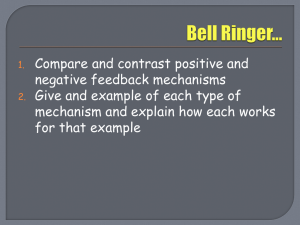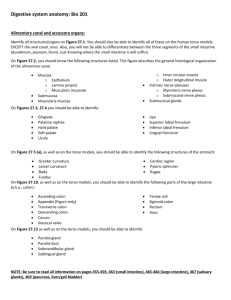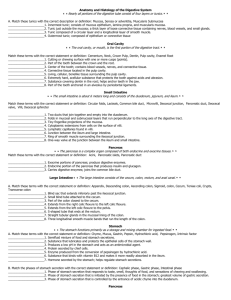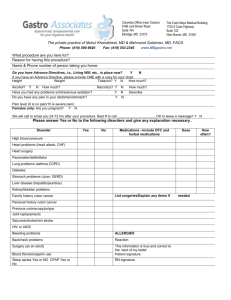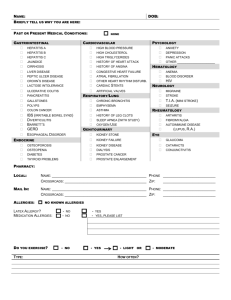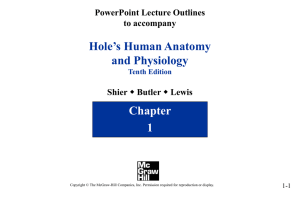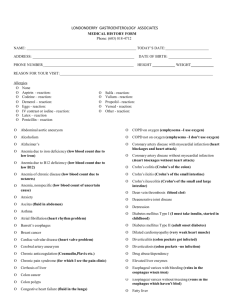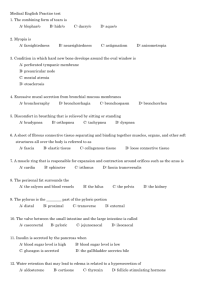File
advertisement
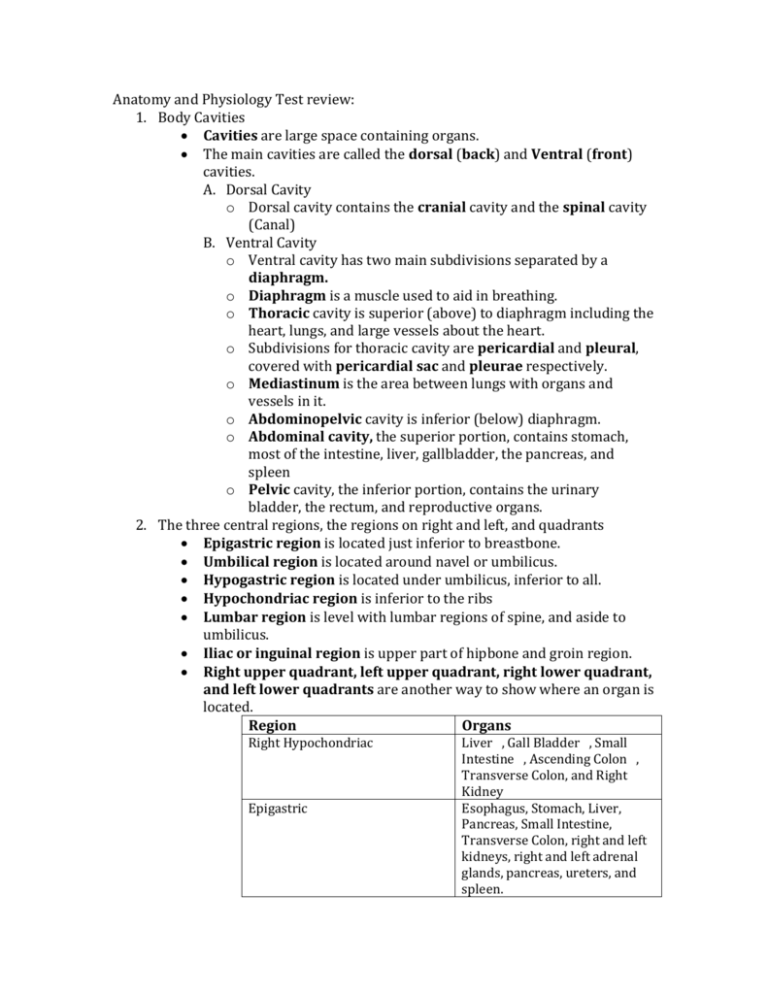
Anatomy and Physiology Test review: 1. Body Cavities Cavities are large space containing organs. The main cavities are called the dorsal (back) and Ventral (front) cavities. A. Dorsal Cavity o Dorsal cavity contains the cranial cavity and the spinal cavity (Canal) B. Ventral Cavity o Ventral cavity has two main subdivisions separated by a diaphragm. o Diaphragm is a muscle used to aid in breathing. o Thoracic cavity is superior (above) to diaphragm including the heart, lungs, and large vessels about the heart. o Subdivisions for thoracic cavity are pericardial and pleural, covered with pericardial sac and pleurae respectively. o Mediastinum is the area between lungs with organs and vessels in it. o Abdominopelvic cavity is inferior (below) diaphragm. o Abdominal cavity, the superior portion, contains stomach, most of the intestine, liver, gallbladder, the pancreas, and spleen o Pelvic cavity, the inferior portion, contains the urinary bladder, the rectum, and reproductive organs. 2. The three central regions, the regions on right and left, and quadrants Epigastric region is located just inferior to breastbone. Umbilical region is located around navel or umbilicus. Hypogastric region is located under umbilicus, inferior to all. Hypochondriac region is inferior to the ribs Lumbar region is level with lumbar regions of spine, and aside to umbilicus. Iliac or inguinal region is upper part of hipbone and groin region. Right upper quadrant, left upper quadrant, right lower quadrant, and left lower quadrants are another way to show where an organ is located. Region Organs Right Hypochondriac Epigastric Liver , Gall Bladder , Small Intestine , Ascending Colon , Transverse Colon, and Right Kidney Esophagus, Stomach, Liver, Pancreas, Small Intestine, Transverse Colon, right and left kidneys, right and left adrenal glands, pancreas, ureters, and spleen. Left Hypochondriac Right Lumbar Umbilical Left Lumbar Right iliac/inguinal Hypogastric Left iliac/inguinal Quadrants RUQ LUQ RLQ LLQ Stomach, tip of liver, pancreas tail, small intestines, transverse colon, descending colon, left kidney, and spleen. Tip of liver, gall bladder, small intestine, ascending colon, and right kidney. Stomach, pancreas, small intestine, transverse colon, pancreas both kidneys and ureters. Small intestine, descending colon, tip of left kidney. Small intestine, appendix, cecum, ascending colon, right ovary (female) and right fallopian tube Small intestine, sigmoid colon, rectum, right and left ovaries, urinary bladder, ureters, urethra, both fallopian tubes, vas deferens, seminal vesicle, and prostate. Small intestine, descending colon, sigmoid colon, left ovary and fallopian tube. Organs Largely liver, gallbladder, tail of the pancreas, right kidney with adrenal gland Stomach, spleen, head of the pancreas, left kidney with adrenal gland Large/small intestines, right ovary (if female) Large/small intestines, left ovary (if female) 3. Levels of Organization Chemicals form cells, which form tissue, which form organs, which form organ systems, which form an organism. 4. Metric System: A. Units of Length o Meter is the basic unit of length. o 1 kilometer is 1000 meter, 1 meter is 100 centimeters, 1 meter is 1000 millimeters, and 1 meter is 1000000 micrometers. o 1 inch is 2.5 cm=25 mm. B. Units of Weight o Same prefixes are used, but the root is gram for weight. o 30 g = 1 ounce, 1 kg = 2.2 pounds. C. Units of Volume o Same prefixes, but the root is liter for volume o 1 L = 1.06 Quarts, 1 fl oz = 30 mL D. Temperature o The measure of temperature in metric system is Celsius. 5. Body Systems A. Tissue sections o Cross-section is the same as transverse section, used to slice though the middle making up and down areas. o Longitudinal section is the same as sagittal or frontal, dividing it into two sides or front and back. o Oblique section is cut in an angle to create a different shape. o These are used in techniques like CT (Computed Tomography) and MRI (Magnetic resonance imaging). 6. Homeostasis, fluid, and feedback A. Homeostasis o Homeostasis is when the body is internally balanced in temperature, composition, fluids, heart rate, respiration rate, and BP. B. Fluid Balance o Fluid that bathes cells, and fluid that goes into and out of cells to provide nutrition is called extracellular fluid. (EX: Blood, lymph, etc.) o Intercellular fluid is inside cells. C. Feedback o Feedback is the main method of maintaining homeostasis. o Negative Feedback is a method where something reverses. o Positive feedback is a method where something continues. Stuff other than listed by the teacher: Metabolism: Life sustaining reactions that occur within the body systems together Catabolism: when molecules or compounds are broken down Anabolism: when simple compounds are joined in together to form a big compound Anatomy: the study of the body structure. Physiology: study of the body’s functions. Pathology: the study of disease The anatomic position: subject is standing upright with face front arms on the sides with palms forward and feet parallel. Superior is a term meaning above. Inferior is a term meaning below. Ventral and anterior: located toward the belly surface or front of the body. Cranial means nearer to the head Caudal means near to the sacral region of the spinal column. Medial means near to the mid-sagittal plane Lateral is towards the side Proximal means near to the origin of the structure. Distal means further from the origin of the structure Frontal plane cuts the body into the anterior and posterior. Sagittal plane cuts the body into the left and right sides. Mid-sagittal is the exact middle. Transverse plane cuts the body horizontally making the inferior and superior sites.
